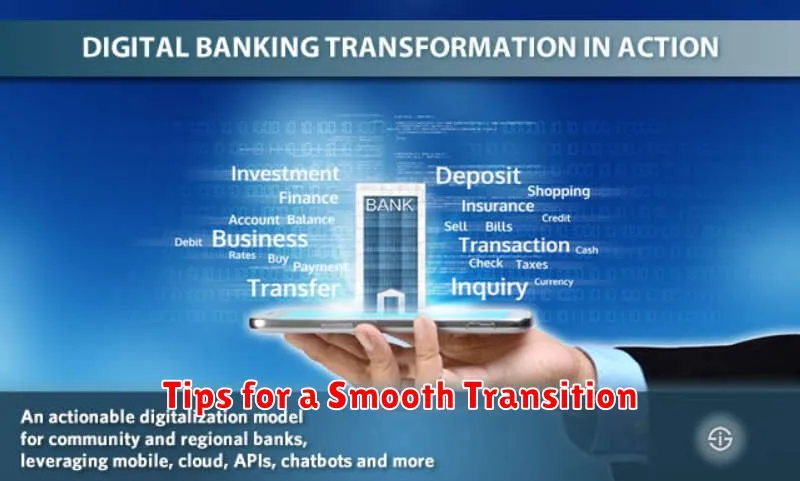In today’s rapidly evolving financial landscape, the shift from traditional banking to digital banking is no longer a futuristic concept, but a present reality. This transition presents both exciting opportunities and crucial considerations for consumers and financial institutions alike. Understanding how to navigate this change effectively is paramount to leveraging the full potential of digital banking while mitigating potential risks. This article will provide a comprehensive guide on how to transition from traditional banking to digital banking, covering key aspects such as security, functionality, and the evolving role of financial technology (FinTech). Whether you’re a seasoned online shopper or just starting to explore the world of mobile banking, this guide will equip you with the knowledge and resources you need to make informed decisions about your financial future.
From managing your accounts on your smartphone to utilizing cutting-edge FinTech solutions, digital banking offers a range of benefits, including increased convenience, enhanced security measures, and access to innovative financial tools. This article delves into the practical steps involved in transitioning to digital banking, covering topics such as choosing the right digital banking platform, setting up online accounts, ensuring online security, and maximizing the benefits of digital banking tools. By embracing digital transformation in the financial sector, individuals can empower themselves to take greater control of their finances and navigate the complexities of modern banking with confidence and ease.
Why Make the Switch?
Traditional banking often involves physical branches, paper statements, and limited access to your finances. Digital banking offers a more convenient and often more cost-effective alternative.
24/7 access to your accounts allows you to manage your finances anytime, anywhere. Features like mobile check deposit, online bill pay, and instant transaction notifications provide greater control and transparency.
Many digital banks offer lower fees and higher interest rates on savings accounts compared to traditional institutions. This can lead to significant savings over time.
Choosing a Trusted Digital Bank
Transitioning to a digital bank requires careful consideration of several factors to ensure the safety and security of your finances. Security is paramount. Look for banks with robust security measures such as multi-factor authentication, encryption, and fraud detection.
FDIC insurance is crucial for protecting your deposits. Confirm the digital bank is FDIC-insured, meaning your funds are protected up to $250,000 per depositor, per insured bank, for each account ownership category.
Features and fees are also important. Does the bank offer the services you need, such as bill pay, mobile check deposit, and customer support? Are there monthly maintenance fees, overdraft fees, or other charges? Carefully compare these factors across different digital banks to find the best fit.
Finally, consider the bank’s reputation and customer reviews. Research the bank’s background and look for reviews from other customers to understand their experiences.
Opening and Verifying an Account Online
The first step in transitioning to digital banking is opening an account online. Most banks offer online applications through their websites or dedicated mobile apps. You’ll need to provide personal information such as your name, address, social security number, and date of birth.
After completing the application, the next step is verification. This process confirms your identity and protects against fraud. Common verification methods include answering security questions, receiving a verification code via email or text, or uploading a photo of your ID.
Transferring Your Funds Securely
Moving your money to a digital platform requires careful consideration of security. Verify the legitimacy of the digital bank. Look for established institutions with robust security measures. Avoid clicking on links in emails or text messages, as these could be phishing attempts.
When initiating transfers, double-check the recipient information and the amount. Utilize strong passwords and enable two-factor authentication whenever possible. Regularly monitor your accounts for any unauthorized activity and report any suspicious transactions immediately.
Redirecting Direct Deposits and Bills

A key step in transitioning to digital banking is redirecting your direct deposits and bill payments. This ensures a seamless flow of funds without interruption.
For direct deposits, contact your employer’s payroll department. Provide them with your new digital bank account information, including the routing and account numbers. Verify processing time to avoid any delays in receiving your paycheck.
To redirect bill payments, access your existing accounts with billers (e.g., utilities, credit card companies). Update your payment information with your new digital banking details. Confirm the changes and consider making a small test payment to ensure accuracy.
Learning the Banking App Interface
Navigating a banking app may seem daunting at first, but it’s designed for user-friendliness. Familiarize yourself with the key features located typically at the bottom or top of the screen. These often include icons for account balances, transactions, transfers, and bill pay.
The account summary page usually displays your available balance and recent transactions. From here, you can delve into specific accounts for more detailed information. The transfer function allows you to move money between your accounts or to external accounts. Bill pay enables you to schedule and pay bills electronically.
Setting Up Security Measures
Transitioning to digital banking requires a heightened focus on security. Strong passwords are crucial. Employ a combination of uppercase and lowercase letters, numbers, and symbols. Avoid easily guessed passwords like birthdays or pet names and utilize a unique password for each account.
Multi-factor authentication (MFA) adds an extra layer of protection. Enable MFA whenever possible. This typically involves receiving a code via text, email, or an authenticator app to confirm your identity.
Regularly monitor your accounts for any suspicious activity. Report any unauthorized transactions immediately to your bank. Keep your devices’ software updated to patch security vulnerabilities.
Managing Without Physical Branches
A key aspect of digital banking is operating without physical branches. This requires a shift in mindset and operational strategies. Customer service becomes primarily digital, relying on robust online platforms, mobile apps, and call centers.
Security is paramount in a branchless environment. Multi-factor authentication, fraud detection systems, and robust cybersecurity measures are crucial for protecting customer data and assets.
Operational efficiency is achieved through automated processes, reducing overhead costs associated with physical locations. This allows for reinvestment in technology and enhanced digital services.
Notifying Contacts and Vendors
Transitioning to digital banking requires notifying relevant parties about the change. This includes updating your contact information with payors like employers and government agencies for direct deposit purposes. You’ll also need to inform vendors who bill you regularly, providing them with your new digital account details to ensure seamless payment processing.
This process may involve updating online profiles, completing change-of-address forms for payments, or contacting vendors directly via phone or email. Ensure all recurring transactions, such as utility bills and subscription services, are switched to the new digital account to avoid missed payments.
Tips for a Smooth Transition

Transitioning to digital banking can feel overwhelming, but these tips can simplify the process. Start slowly. Don’t feel pressured to move everything at once. Begin by exploring a few key features like online bill pay or mobile check deposit.
Ensure strong security. Choose a strong and unique password. Enable two-factor authentication for added protection. Regularly review your account activity for any unauthorized transactions.
Stay organized. Download your bank’s mobile app and set up account alerts. This helps you track balances and transactions in real-time, minimizing the risk of overdrafts or missed payments.
Familiarize yourself with the platform. Explore the various features offered by your digital banking platform. Many banks offer tutorials and FAQs to guide you through the process.

